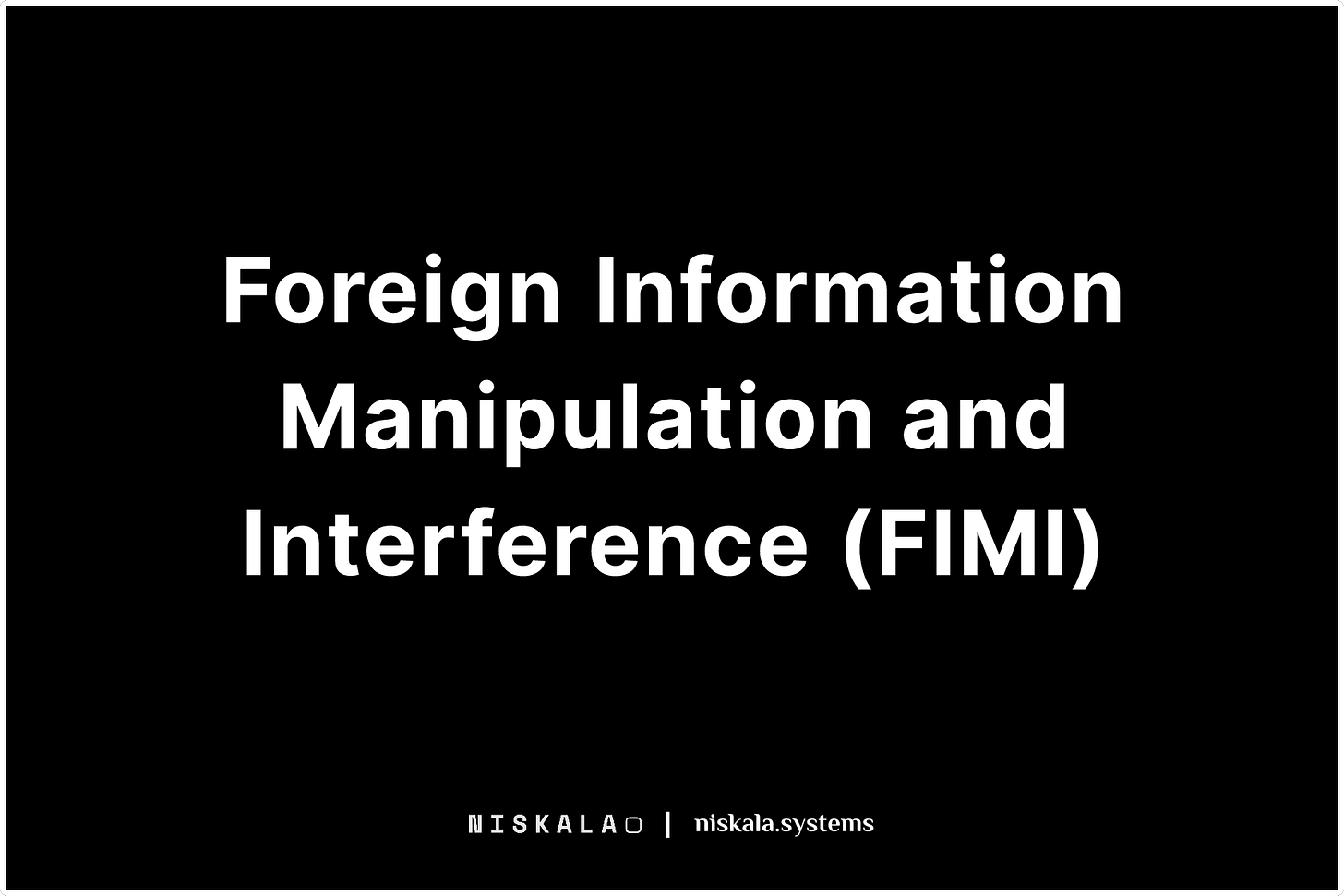Foreign Information Manipulation and Interference: The War Without a Declaration
Understanding the Quiet Mechanics of Belief Disruption in the Age of Networked Influence
In recent years, the term Foreign Information Manipulation and Interference (FIMI) has surfaced across official reports, strategic documents, and security briefings. To the uninitiated, it may seem like an abstract concern—another bureaucratic acronym nested within international policy circles.
But FIMI is not a fringe issue. It is not a future threat.
It is the present condition of the information environment.
FIMI represents one of the most pervasive forms of contemporary interference: a slow, strategic erosion of narrative sovereignty, designed to influence public perception, fracture consensus, and destabilize democratic resilience—without crossing a single physical border.
This signal offers a grounded overview of what FIMI is, how it operates, and why resisting it requires more than detection or fact-checking. It requires narrative immunity: a population capable of interpreting manipulation without collapsing into paranoia.
What Is FIMI, and Why Language Matters
The formal definition provided by entities such as the European External Action Service’s (EEAS) StratCom Task Force describes FIMI as:
“Activities that are carried out by foreign actors, which are manipulative in nature and intended to influence public opinion or decision-making.”
While the term itself may appear sterile, its implications are anything but. FIMI is not simply a modern rebranding of propaganda. It encompasses a vast, multi-modal system of operations aimed at undermining trust, coherence, and the psychological infrastructure of belief itself.
FIMI is deployed not to convince, but to destabilize.
It relies on ambiguity, emotional volatility, and the weaponization of doubt. And crucially, it operates not through centralized channels, but through decentralized, memetic, and often user-generated vectors of influence.
The Strategic Anatomy of FIMI
FIMI strategies vary widely in format and intensity, but typically share a set of identifiable characteristics:
1. Attribution Avoidance
Unlike traditional state-sponsored propaganda, FIMI is designed to obscure its origin. Bots, trolls, cut-outs, proxy influencers, and content laundering all serve to create the illusion of grassroots activity.
2. Emotionally Charged Framing
Narratives are crafted to activate moral reflexes—outrage, disgust, indignation—rather than to persuade through rational argument. These emotional spikes increase virality and decrease critical distance.
3. Fragmentation over Persuasion
The goal is often not to shift belief toward a specific narrative, but to fragment shared sensemaking altogether. This results in an exhausted, divided, and reactive public—easier to manipulate, harder to mobilize.
4. Narrative Saturation
Rather than broadcasting a single message, FIMI actors flood the space with conflicting narratives. This “fog of narratives” creates a kind of epistemic fatigue, in which truth feels inaccessible and all claims appear equally suspect.
5. Cultural Camouflage
Messages are tailored to blend into the local informational ecology. This includes adopting domestic slang, co-opting activist language, and mimicking native media formats to avoid detection.
Contemporary Examples
Russia’s Disinformation Campaigns
Across Europe and North America, Russian actors have been documented disseminating conflicting narratives around COVID-19 vaccines, climate policy, and national elections. These narratives often contradict one another, but their shared effect is confusion, distrust, and polarisation.
China’s Influence Operations
Chinese FIMI techniques tend to focus more on amplification and distraction than overt fabrication. By flooding information ecosystems with redundant or seemingly neutral content, they bury critical narratives and shape online visibility without appearing overtly manipulative.
Non-State Actors and Extremist Groups
Groups such as ISIS have leveraged FIMI-style tactics by crafting visually compelling propaganda and distributing it across decentralized platforms, effectively bypassing traditional gatekeepers and recruiting through aesthetic-emotional appeals.
Why FIMI Is Difficult to Fight
Most institutional responses to FIMI focus on detection, attribution, and takedown. While these are necessary, they are fundamentally reactive. The deeper threat of FIMI is not the content itself—but the dispositional drift it produces within the target audience.
That is: even if falsehoods are removed, their residue—mistrust, outrage, apathy—remains.
FIMI works not by implanting new beliefs, but by dismantling belief formation as a coherent process. It targets the psychological architecture of meaning-making.
In this light, fact-checking and platform moderation, though useful, cannot serve as primary defenses. The long-term solution lies not in better filters, but in more resilient minds.
Toward Narrative Immunity
Countering FIMI at scale will require what NISKALA calls narrative hygiene: a form of cognitive self-discipline that enables individuals to recognize manipulation without overcorrecting into cynicism.
This includes:
Understanding Framing: Being able to identify the implicit emotional positioning of a message.
Emotional Regulation: Delaying reaction in high-friction information environments.
Pattern Recognition: Detecting the repetition of weaponized tropes (e.g., moral panic, hero-villain binaries).
Semantic Filtering: Noticing when language is operating as suggestion rather than signal.
Narrative immunity does not mean disengagement. It means maintaining psychological clarity under exposure.
Conclusion: FIMI as the New Normal
FIMI is not an exception to the information environment. It is now an embedded condition. It reshapes not only what we think, but how we think—and how we relate to others who think differently.
The challenge it presents is not merely political or informational. It is existential.
Because when belief itself becomes suspect, governance, trust, and community all begin to erode.
The future of information integrity will not be decided in think tanks or content moderation policies alone. It will be shaped by whether individuals and collectives can develop the inner infrastructure necessary to walk through narrative distortion without becoming distorted themselves.
📍 Postscript
This signal is published as part of NISKALA Signal, a precision broadcast exploring the deep mechanics of language, belief, and influence in a post-truth landscape.



